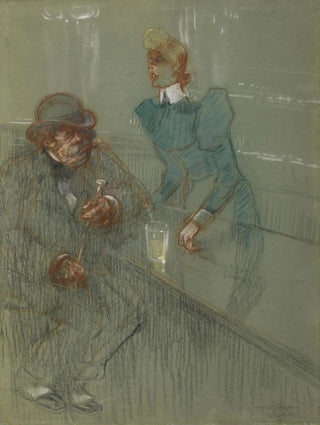Art print | Barmaid - Henri de Toulouse-Lautrec Source: Reproduction | Barmaid - Henri de Toulouse-Lautrec


View from behind

Frame (optional)
In the vibrant universe of the late 19th century, Henri de Toulouse-Lautrec emerges as a privileged witness to Parisian nightlife. His famous work, "Barmaid," perfectly embodies this era when cabarets and cafés were the beating heart of the French capital. Through this canvas, the artist immerses us in the electric atmosphere of Parisian establishments, where characters mingle in a dance of colors and shapes. The art print Barmaid - Henri de Toulouse-Lautrec thus becomes an open window to a bygone world, yet still fascinating, where every detail tells a story.
Style and uniqueness of the work
The uniqueness of "Barmaid" lies in how Toulouse-Lautrec captures the very essence of his subjects. With a bold color palette and flowing lines, he manages to convey not only the physical appearance of the barmaid but also her state of mind. This woman, both strong and vulnerable, is depicted with an intensity that transcends a simple portrait. The play of light and shadow, as well as stylized contours, creates a dynamic that draws the eye and invites exploration. The work stands out for its modern approach, where the artist abandons academic conventions to focus on emotional expression. Each brushstroke seems to vibrate with a life of its own, testament to Toulouse-Lautrec's technical skill and his ability to capture the moment.
The artist and his influence
Henri de Toulouse-Lautrec, born in 1864, is often considered one of the pioneers of the post-impressionist movement. His life, marked by personal and physical challenges, profoundly influenced his art. By frequenting cabarets and entertainment venues, he immortalized the iconic figures of La Belle Époque, making his works valuable testimonies of this period. His unique style, blending realism and abstraction, paved the way for many contemporary and future artists. Toulouse-Lautrec managed to capture not only faces but also the soul of his subjects, giving them palpable humanity. His influence endures, inspiring generations of artists to explore life

Matte finish

View from behind

Frame (optional)
In the vibrant universe of the late 19th century, Henri de Toulouse-Lautrec emerges as a privileged witness to Parisian nightlife. His famous work, "Barmaid," perfectly embodies this era when cabarets and cafés were the beating heart of the French capital. Through this canvas, the artist immerses us in the electric atmosphere of Parisian establishments, where characters mingle in a dance of colors and shapes. The art print Barmaid - Henri de Toulouse-Lautrec thus becomes an open window to a bygone world, yet still fascinating, where every detail tells a story.
Style and uniqueness of the work
The uniqueness of "Barmaid" lies in how Toulouse-Lautrec captures the very essence of his subjects. With a bold color palette and flowing lines, he manages to convey not only the physical appearance of the barmaid but also her state of mind. This woman, both strong and vulnerable, is depicted with an intensity that transcends a simple portrait. The play of light and shadow, as well as stylized contours, creates a dynamic that draws the eye and invites exploration. The work stands out for its modern approach, where the artist abandons academic conventions to focus on emotional expression. Each brushstroke seems to vibrate with a life of its own, testament to Toulouse-Lautrec's technical skill and his ability to capture the moment.
The artist and his influence
Henri de Toulouse-Lautrec, born in 1864, is often considered one of the pioneers of the post-impressionist movement. His life, marked by personal and physical challenges, profoundly influenced his art. By frequenting cabarets and entertainment venues, he immortalized the iconic figures of La Belle Époque, making his works valuable testimonies of this period. His unique style, blending realism and abstraction, paved the way for many contemporary and future artists. Toulouse-Lautrec managed to capture not only faces but also the soul of his subjects, giving them palpable humanity. His influence endures, inspiring generations of artists to explore life






